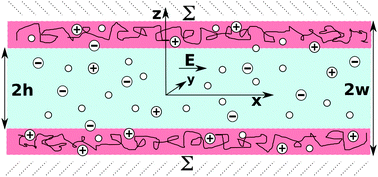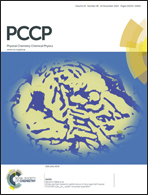Electro-osmotic flow in coated nanocapillaries: a theoretical investigation
Abstract
Motivated by recent experiments, we present a theoretical investigation of how the electro-osmotic flow occurring in a capillary is modified when its charged surfaces are coated with charged polymers. The theoretical treatment is based on a three-dimensional model consisting of a ternary fluid-mixture, representing the solvent and two species for the ions, confined between two parallel charged plates decorated with a fixed array of scatterers representing the polymer coating. The electro-osmotic flow, generated by a constant electric field applied in a direction parallel to the plates, is studied numerically by means of Lattice Boltzmann simulations. In order to gain further understanding we performed a simple theoretical analysis by extending the Stokes–Smoluchowski equation to take into account the porosity induced by the polymers in the region adjacent to the walls. We discuss the nature of the velocity profiles by focusing on the competing effects of the polymer charges and the frictional forces they exert. We show evidence of the flow reduction and of the flow inversion phenomenon when the polymer charge is opposite to the surface charge. By using the density of polymers and the surface charge as control variables, we propose a phase diagram that discriminates the direct and the reversed flow regimes and determines their dependence on the ionic concentration.


 Please wait while we load your content...
Please wait while we load your content...